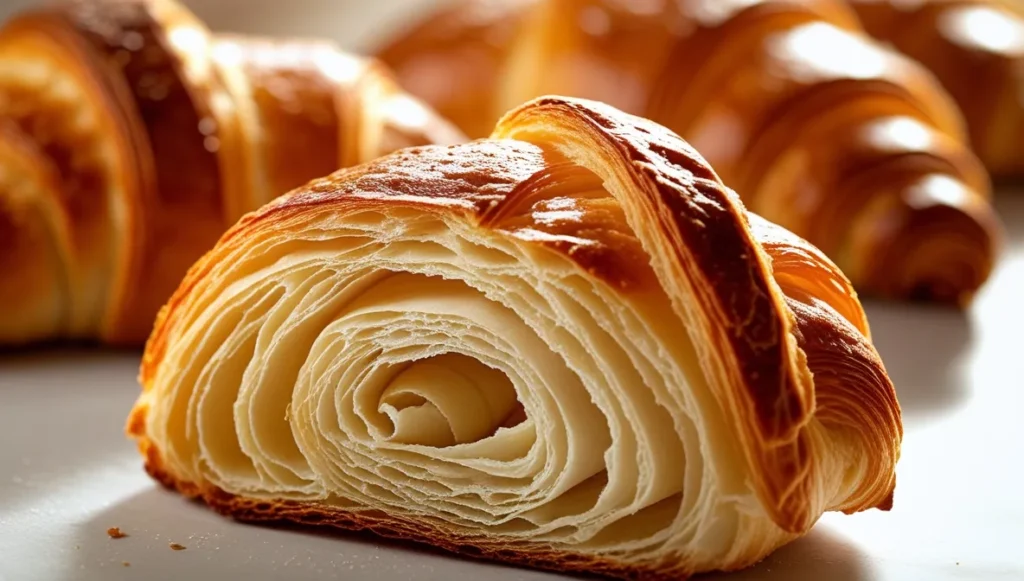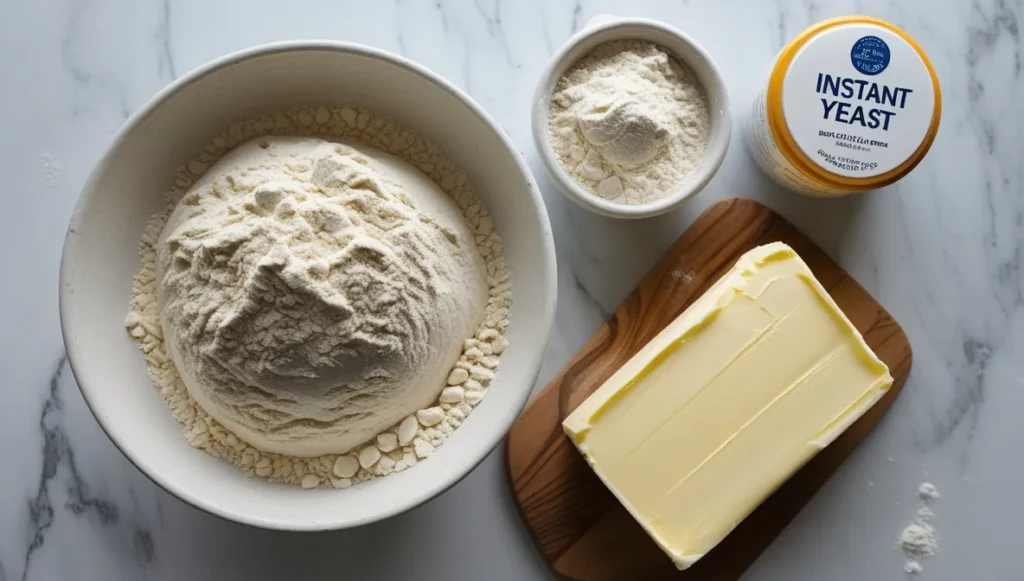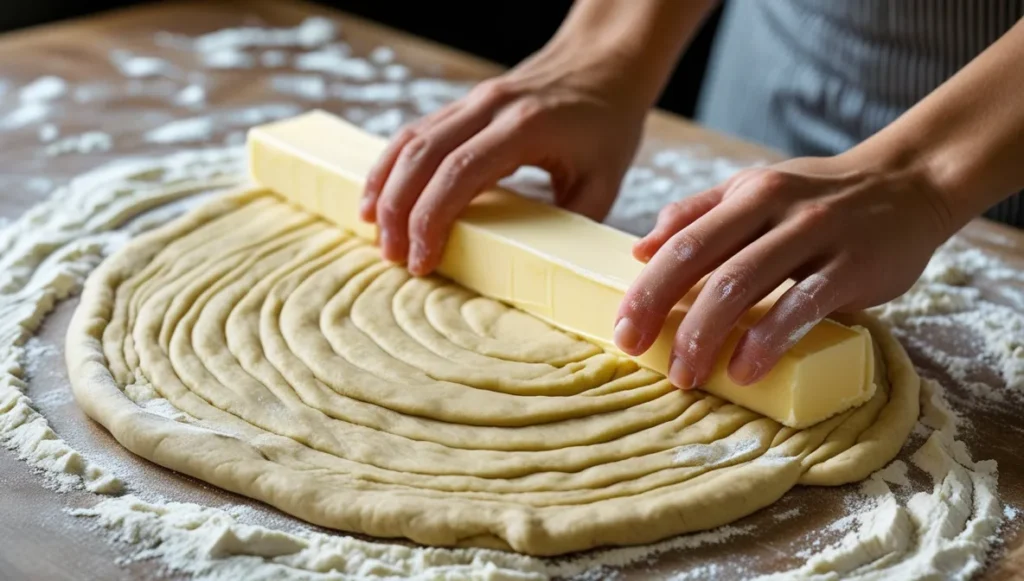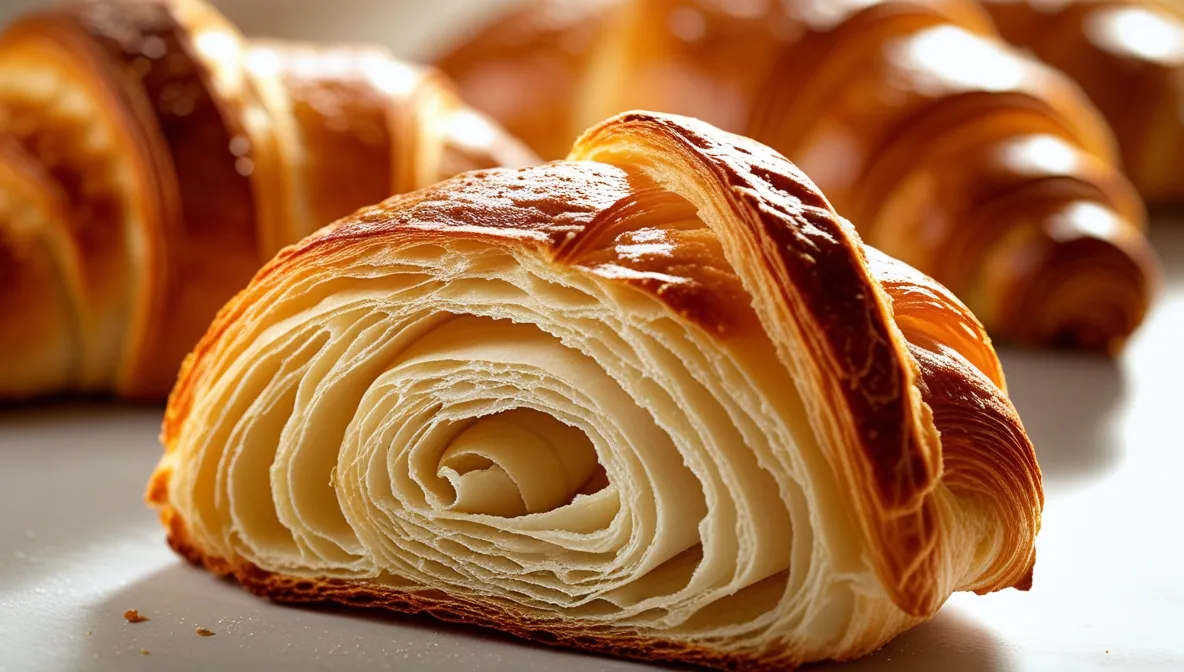The **gluten free croissant** is often considered the peak of difficulty in baking. Without the elasticity of wheat gluten, achieving the thousands of flaky, airy layers is a monumental challenge. However, this ultimate **gluten free croissant recipe** leverages specialized techniques and binders to successfully mimic the flakiness of traditional French pastry, delivering an **amazing** result that makes this elegant pastry accessible to everyone.

Mastering this recipe requires patience and temperature control, but the result is a rewarding, buttery pastry perfect for your **Breakfast** or **Quick Recipes** menu. We will detail the specific role of binders, the importance of cold butter, and the folding techniques necessary for achieving the signature layers of the **gluten free croissant dough**.
- Essential Binders for Gluten Free Croissants
- The Critical Role of Cold Butter (Lamination)
- The Folding Process: Creating Flaky Layers
- Proofing and Baking the Gluten Free Croissant
- Serving Suggestions and Flavor Variations:
- Gluten Free Croissant Alternatives (Quick Recipes):
- FAQ: Your Questions About Gluten Free Croissants
- Conclusion: The Ultimate Baking Triumph
- Recipe Summary: Quick Gluten Free Croissant
- → Butter Block (Beurrage)
- Tools You’ll Need
The Science of Gluten Free Croissant Dough
In a traditional croissant, gluten creates the strong network that allows the dough to be rolled paper-thin without tearing. Since this network is absent, a successful **gluten free croissant recipe** must rely on specialized ingredients to perform the same function.
Essential Binders for Gluten Free Croissants
The secret to a pliable, non-tearing **gluten free croissant dough** is the specific blend of starches and binders:
- **High-Quality GF Blend:** A fine blend is needed (often rice flour, tapioca, and potato starch).
- **Xanthan Gum & Psyllium Husk:** These binders are non-negotiable. Xanthan gum adds elasticity, while powdered psyllium husk adds robust structure and absorbs liquid, preventing the dough from becoming a greasy mess.
- **Acid:** A small amount of apple cider vinegar or lemon juice is often added to the liquid to help the psyllium husk structure form better.

The Critical Role of Cold Butter (Lamination)
Lamination is the process of folding a cold slab of butter (the *beurrage*) into the dough (the *détrempe*) to create alternating layers. The butter must remain cold and separate during rolling. High-quality European butter is recommended because its higher fat content and lower water content make it more pliable and less likely to melt into the dough, which would result in a flat, oily pastry.
Mastering the Lamination Technique for Gluten Free Croissant Dough
The lamination process is time-consuming, requiring several folds and chilling periods. Patience is rewarded with an airy, flaky interior.
The Folding Process: Creating Flaky Layers
The **gluten free croissant** requires 3 to 4 turns (folds) with chilling time between each fold to keep the butter firm. The total folding process creates dozens of ultra-thin layers of butter between the dough.

- **Initial Envelope:** Enclose the cold butter block fully within the dough to create an envelope.
- **Rolling and Folding:** Roll the dough into a long rectangle. Perform a **Letter Fold** (folding the top third down, then the bottom third up). Wrap and chill for 30–60 minutes.
- **Turning:** Rotate the dough 90 degrees and repeat the rolling and folding process (a second “turn”). Repeat this entire step two more times for a total of four folds.
- **Shaping:** After the final chill, roll the dough thin, cut into triangles, and roll into crescent shapes.
The chilling time is essential. If the butter begins to melt and seep out during rolling, the lamination will be ruined. If the dough is sticky or difficult to roll, stop immediately and return it to the refrigerator. This is the difference between an airy **gluten free croissant** and a dense roll.
Proofing and Baking the Gluten Free Croissant
The proofing (final rise) and baking stages are delicate for **gluten free croissants**:
- **Proofing:** Due to the strength of the non-wheat binders, the dough requires a longer proofing time (often 3–4 hours) in a slightly warm, humid environment to achieve maximum volume.
- **Baking:** The final bake should start hot (around $400^\circ\text{F}$ or $425^\circ\text{F}$) to quickly set the outer layers and create a dramatic lift, then the temperature is often reduced to cook the interior fully without burning the butter.
For additional authoritative instruction on lamination and dough handling, consult **King Arthur Baking’s Lamination Guide**.
Serving, Variations, and Quick Alternatives
A fresh **gluten free croissant** is a luxurious treat, perfect for any occasion. It is best enjoyed immediately after cooling.
Serving Suggestions and Flavor Variations:

- **Sweet:** Serve warm with butter, homemade jam, or fill with chocolate before rolling (pain au chocolat).
- **Savory:** Use a **gluten free croissant** as the base for an elegant sandwich, filling it with ham and Swiss, egg salad, or tuna salad (a quick option like our Tuna Salad Recipe).
- **Quick Fix:** For a significantly faster, bread-like option, try making **gluten free crescent rolls** using a simpler dough that skips the full lamination process.
Gluten Free Croissant Alternatives (Quick Recipes):
If the 4+ hour process of making true laminated **gluten free croissants** isn’t feasible, there are quicker alternatives:
- **Quick Crescent Rolls:** Use a simple GF quick-bread dough made with baking powder. The texture will be bread-like, not flaky, but it offers the classic crescent shape in under an hour.
- **Freezing:** Croissants freeze well after they are shaped but *before* proofing. Wrap them tightly and freeze. When ready to bake, let them proof overnight in the refrigerator, then warm proof for an hour before baking.
This demanding bake, while time-consuming, is a worthy addition to your skills. For a reliable savory dinner that is also a comforting **Quick Recipes** meal, our guide to the **[Crockpot Ravioli Lasagna]** (https://flavorillarecipes.com/crockpot-ravioli-lasagna) is highly recommended.
FAQ: Your Questions About Gluten Free Croissants
Are croissants gluten free?
**Are croissants gluten free?** No, traditional croissants are not gluten-free as they are made from wheat flour and butter. The entire structure relies on the gluten protein network created during the lamination process. However, excellent substitutes can be made using specialized gluten-free flour blends and binders.
What makes gluten free croissants flaky?
Gluten-free croissants achieve their flakiness through **lamination** (folding a solid block of cold butter into the dough) and the use of **binders** like psyllium husk and xanthan gum. The binders mimic the elasticity of gluten, allowing the dough to be rolled and folded multiple times without tearing, creating separated layers of fat and starch.
Where to buy gluten free croissants?
You can buy pre-made **gluten free croissants** frozen from specialty online retailers or some major grocery stores. Popular brands, such as Schär, often offer pre-made, bake-at-home versions.
What is the best flour for a gluten free croissant recipe?
The **best flour for a gluten free croissant recipe** is a fine-milled, rice-based blend, often supplemented with starches like tapioca and potato. More importantly, the blend must include a high concentration of **xanthan gum and psyllium husk powder** to provide the necessary structure for lamination.
Conclusion: The Ultimate Baking Triumph
The **gluten free croissant** is a profound baking triumph. By embracing the complexity of lamination and utilizing non-wheat binders, you can achieve a truly flaky, buttery, and satisfying pastry.
This **amazing** **gluten free croissant recipe** is a celebration of flavor and technique, proving that no pastry is off-limits. Enjoy this unique **Breakfast** treat!
Recipe Summary: Quick Gluten Free Croissant
→ Dough Ingredients (Détrempe)
- 2 $\frac{1}{2}$ cups GF All-Purpose Flour Blend
- 1 tsp Xanthan Gum, 1 tbsp Psyllium Husk Powder
- 1 tsp Yeast, 2 tbsp Sugar, $\frac{1}{2}$ tsp Salt
- 1 cup Milk (cold), $\frac{1}{2}$ cup Water (cold)
→ Butter Block (Beurrage)
- 1 cup (2 sticks) High-Fat European Butter, cold
- $\frac{1}{4}$ cup GF Flour (for dusting)
Steps to Follow (The Lamination)
- **Dough:** Mix cold dough ingredients. Knead lightly, wrap, and chill for 1 hour.
- **Lamination:** Form a cold butter block. Enclose the butter within the dough. Roll and perform 4 consecutive turns (folds), chilling the dough for 30–60 minutes after each fold.
- **Proof:** Shape the croissants. Proof for 3–4 hours in a warm, humid environment until puffy.
- **Bake:** Preheat oven to 400°F (200°C). Brush with egg wash and bake for 18–20 minutes until golden brown.
Tools You’ll Need
- Stand Mixer with Dough Hook
- Rolling Pin and Bench Scraper
- Parchment Paper

